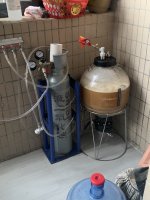I cheat when I make low ABV lagers because the style, as written, suggests that low ABV lagers should be bland and dull. It doesn't have to be that way.
I use Continental pils malt rather than domestic. Paired with 33% corn, or corn and rice, it keeps the beer tasting like beer without compromising its dryness. I would argue that a step mash is necessary, but Annie Johnson famously won a best of show at the AHA with a recipe that calls for a single infusion. Leave the carafoams and carahells out of the grist, they'll only add flabbiness. Stick to your base malt and adjuncts.
Regarding water, I've made the style with calcium-poor ultra-soft water and I've also made it with gypsum leading the charge. Either approach makes a nice beer. The soft water route makes an elegant beer that lets the hops show off their floral notes and lets the corn provide that creamy rounding off of the corners. The chunkier water sacrifices a bit of the soft elegance for a more thirst-quenching bite. I like soft water in the Spring and chunky water in the Summer and Fall.
It's in the hopping schedule where I embrace the depraved, low-down, dirty business of cheating on this style. I'm a big believer in 20min hops, so I like to split my bittering charge into a very small FWH addition of Magnum (or whatever clean, high IBU hop you use) and a larger 20min addition of your starring hop. I really like Hallertauer Mittelfrüh for this style, the style gives HM an opportunity to really express its floral traits against the delicate grist. I also employ a 10min charge and whirlpool charge. Clusters, Vanguard, Crystal, and the usual German, Czech, and French suspects all make outstanding beers. Whichever you choose, make certain that it's in excellent condition. The delicate grist is going to place your hop of choice at center stage, bucknaked, under a spotlight. This isn't the place to dispose of that mystery bag that you found at the back of the freezer. Also, don't be afraid to dry hop.
Here's an example of how I brew the style. It ticks the boxes in terms of the metrics of the style, but it's a shameless exercise in cheating the spirit of the style. If you've never understood why "floral" is used as a descriptor of Hallertauer Mittelfrüh, this recipe will put that trait on full display--assuming you have hops that are in good condition. All percentages of the grist are rounded up to the nearest whole number, and if you're wondering, "panther piss" is my father's favorite appellation for lousy beer.
Panther Piss: An Aquatic Odyssey
For 6gal into the fermenter
OG: 1.040
FG: 1.009
ABV: 4.1%
Mash following the hochkurz technique. Adjust pre-boil wort to pH 5.2, boil 90min.
German Pils Malt 68%
Corn 21%
Rice 11%
.1oz Magnum FWH
.5oz Hallertauer Mittelfrüh @20
.5oz Hallertauer Mittelfrüh @10
1oz Hallertauer Mittelfrüh whirlpool @170F for 10min
(Optional .5oz Hallertauer Mittelfrüh dry hops in primary @ 4days for 72hrs ~3/4 gravity)
34/70 or S-189. Pitch at 48F and raise to 50F after the first quarter of gravity. Raise to 52F at half gravity. Raise to 55F at 3/4 gravity. D-rest not necessary, crash at full attenuation.

























































